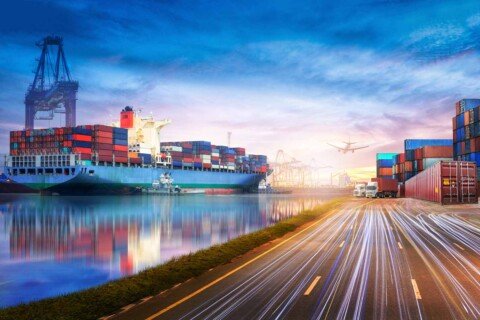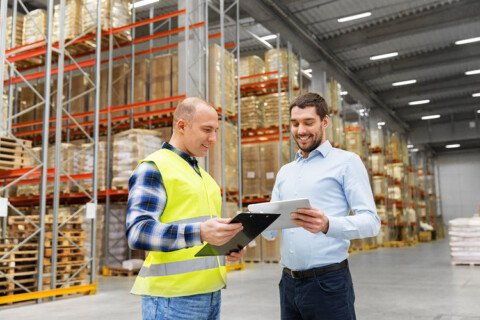India’s success and economic growth in the future is heavily dependent on the evolution of its logistics sector. This is essential not only for generating employment or providing broad social benefits to farmers and low-income workers but also for competing with the rest of the world in terms of last-mile connectivity, efficient transportation, time of delivery, etc. This will give an overall boost to India’s image as an attractive investment destination and facilitate India’s manufacturing export performance, which is already soaring as India’s domestic demand, demographics, and government programmes encouraging manufacturing has put the country in a unique position.
Upamanyu Borah
In the current fast-evolving post-pandemic scenario, as global companies adapt their manufacturing and supply chain strategies to build resilience, India has been able to capture a unique opportunity to become a global manufacturing hub. The country has three primary assets to capitalise on this: the potential for significant domestic demand, the government’s drive to encourage manufacturing, and a distinct demographic edge, which include a considerable proportion of young workforce.
The government at the centre has already unleashed bold and transformational reforms which will bolster India’s efforts in becoming a global champion and the manufacturing hub of the world. The production linked incentive schemes, reforms in labour laws, GST, corporate tax rationalisation and an overall ease in doing business is poised to give a fillip to India’s growth. Now, the industry and its stakeholders must seize the opportunities in sunrise areas of growth, which would require size, scale, speed of action, and a strong focus on technological disruption.
India’s ability to lead and globally drive the sunrise sectors of growth holds the key to sustained growth, advancement, and most importantly, job creation. A thriving manufacturing sector will generate additional benefits and help India deliver on the imperatives to create economic opportunities for nearly 100 million people likely to enter its workforce in the coming decade, to distribute wealth more equitably and to contain its burgeoning trade deficit.
A recently released World Economic Forum’s White Paper titled Shifting Global Value Chains: The India Opportunity, produced in collaboration with management consulting and advisory firm Kearney, found India’s role in reshaping Global Value Chains (GVCs) and its potential to contribute more than US$500 billion in annual economic impact to the global economy by 2030. The White Paper presents five possible paths forward for India to realise its manufacturing potential.
The insights presented in the White Paper reflect the perspectives of leaders from multiple industries in the region. The five possible solutions include:
- Coordinated action between the government and the private sector to help create globally competitive manufacturing companies
- Shifting focus from cost advantage to building capabilities through workforce skilling, innovation, quality, and sustainability
- Accelerating integration in global value chains by reducing trade barriers and enabling competitive global market access for Indian manufacturers
- Focussing on reducing the cost of compliance and establishing manufacturing capacities faster
- Focussing infrastructure development on cost savings, speed, and flexibility
“A thriving manufacturing sector could potentially be the most critical building block for India’s economic growth and prosperity in the coming decade. The ongoing post-COVID rebalancing of Global Value Chains offers India’s government and business leaders a unique opportunity to transform and accelerate the trajectory of manufacturing sector,” said Viswanathan Rajendran, Partner, Kearney.
Meanwhile, Cushman & Wakefield’s 2021 Global Manufacturing Risk Index showed India has emerged as the second most sought after manufacturing destination across the world indicating the growing interest shown by manufacturers in India as a preferred manufacturing hub over other countries, including the US and those in the Asia-Pacific region.
This year, India and the US switched places—second and third—taking India one rank above from the rankings released last year, when India stood at the third place.
India had moved up to the third place from the fourth spot last year and now has gained one more spot upward to rank after China.
The rising focus on India can be attributed to India’s operating conditions and cost competitiveness. Also, the country’s proven success in meeting outsourcing requirements has led to the increase in the ranking year on year.
“India in its growth story transitioned from an agricultural economy to a services economy. The country nearly skipped the manufacturing leg of this transition. Yet, on the back of cost and talent, India finds itself favourably placed in the global rankings. Indian manufacturing has also shown great resilience during and post the second wave of COVID-19. But to have greater investor confidence and unleash the Make In India agenda, we will have to address land and labour reforms and also infrastructure across sectors,” said Anshul Jain, Managing Director – India and South East Asia, Cushman & Wakefield was quoted saying to the ET.
Logistics resilience holds key
India’s logistics industry provides significant macro contributions to the national economy by creating employment and generating foreign investment influx. It currently contributes more than US$200 billion to the economy and employs more than 40 million people. Thus, it holds critical importance as it connects various markets, suppliers and business areas like material handling, warehousing, packaging, supply chain management, procurement, and customs service dotted across the country.
In practical, two main forces that helped the logistics industry to overcome the adversities of the pandemic and consequent lockdowns are major manufacturing hubs resuming production, and the rise in domestic consumption across all categories.
While there was a sharp fall in freight availability due to restrictions on production of non-essential goods, at the same time logistics services were crucial for the distribution of many essential items. Warehousing demand shot up for products where manufacturers were unable to take delivery of raw materials in the pipeline. Most of the logistics industry functioned with energy and readiness to the challenges of COVID, balancing the peaks and drops in demand while protecting its staff and customers.
Now more than ever, the industry is realising the need to focus on ensuring efficient and swift logistics and transportation solutions that would ensure quick and secure delivery of goods across end points.
“The logistics sector is the backbone of India’s continued rapid economic growth. It is one of the most critical accelerators of trade, which is also vital for fulfiling the objective of Atmanirbhar Bharat,” said Debasish Debsikdar, AVP and SBU Head– Transportation & Logistics Division, NEC Corporation India.
“India’s logistics sector is making an effort to be more inclusive of a digitally and technologically advanced system to address the higher transaction costs as well as adopt the global best practices.”
“Private players must work together with the government to strengthen domestic integration, synchronisation, and industry coordination. 2021 is a tipping point in India’s growth and revival from the COVID-19 hit economy,” Debsikdar noted.
“NEC India is aggressively working on creating solutions and ensuring value through NEC’s global COEs. Our teams are leveraging industry knowledge to fulfil the country’s logistics sector requirements. Overall, we are aiming at the ‘India Go Big’ initiative by leveraging our solution development and delivery capability from India to aid global business growth and serve as a worldwide delivery hub for offshore support and product development. Hence, we plan to expand the portfolio and the depth of solutions and services offered in the Indian market and abroad,” he informed.
Logistics players and analysts are convinced about the sector’s performance as they are hopeful that e-commerce firms will continue to push for cost-efficient and swift last-mile deliveries. Besides, the growing demand for cold chains, and with India vying to be a manufacturing hub, the requirement for large automated warehouses and omni-channel logistics solutions will continue to grow.
As per Savills India, industrial and warehousing space absorption is expected to grow 83% y-o-y to 47.7 mn sq ft in 2021, driven by robust growth in e-commerce and manufacturing as well as rising demand in emerging tier II and III cities.
On the supply side, Savills India expects a 113% increase in supply to 47.9 mn sq ft in 2021. Despite construction activities getting affected due to the lockdown, the top eight cities of India witnessed a fresh supply of 22.5 mn sq ft last year.
In 2020, the industrial and warehousing market witnessed investments in excess of US$1 billion. The growing number of firms in these two sectors and the huge Indian consumption market has whipped up the investment prospects of the India’s warehouse sector.
Also, there is an increased focus into logistics subcategories like cold chain, in-city warehousing, MMLPs, FTWZs, MEPZs, liquid storages, ready factory fitted out buildings, which meet Environmental, Social and Governance (ESG) standards.
“Existing growth potential and India’s cost advantage will continue to help in attracting sizeable foreign investment into the manufacturing sector,” explained Ajay Joshi, Director– Industrial & Logistics, Savills India.
“The investment cycle is on an uptick backed by the e-commerce boom, increased number of 3PLs improving infrastructure, and freight corridors. Investments in the form of debt funding, equity investments in rental yielding assets, and entry of new global and sovereign wealth funds can be expected in 2020-21.”
“Growing demand for cold chain warehouses as well as growth in e-commerce and organised retail are likely to drive warehousing demand in 2021. In addition, strong macro-economic fundamentals and government’s policy support and implementation will continue to fuel growth for the entire sub asset class of logistics,” Joshi said.
“The industrial sector is set to benefit as multinationals seek to diversify their manufacturing locations. India is emerging as an alternate manufacturing investment destination for China. This would lead to an increased demand for both ready high spec fitted out and custom-built industrial spaces in tier II and III cities across UP, Punjab, Gujarat, Andhra Pradesh, West Bengal, Madhya Pradesh, particularly from the growing sectors such as such as cold chain, pharmaceuticals, medical devices, mobiles and electronics, FMCG, automobiles and spare parts, solar equipments, food processing, and textiles,” he added.
“Favourable policies are helping the industry to move from a ‘tax planning’ to a ‘supply chain planning’ efficiency model,” said Ashish Sharma, Director– Contract Logistics for CEVA Logistics (India). “Changing consumer behaviour is encouraging e-commerce buying patterns. All these factors require a very well-oiled and agile supply chain, meaning the supporting infrastructure, in terms of transport and storage should be highly efficient, scalable, and accessible.”
“As a result, we see growth in the warehousing sector with a large number of companies looking to consolidate their facilities and aspiring for more and more tech-driven facilities. E-commerce is pushing the supply chain to gear up for servicing tier II and III cities, resulting in the growth of efficient and scalable warehousing across locations within India.”
“At present, investors are upbeat about the warehousing sector due to the continued growth of the e-commerce industry leading to an increase in demand for Grade A facilities,” said Abhijit Malkani, Co-CEO and Country Head, ESR India.
“Additionally, availability of quality infrastructure, reforms to further enhance Ease of Doing Business will attract international players and provide the necessary impetus to fuel the growth of manufacturing in India.”
“Cold storage has become a crucial asset class during the pandemic, fuelled by online grocery commerce and pharmaceutical companies. The shift from Grade B to Grade A expedited during the pandemic with companies wanting to consolidate their operations and implement automation and digitisation,” highlighted Malkani.
“Another major trend observed in the warehousing industry is the growing demand for ‘Ready Spaces’ or buildings with a shorter delivery timeline at select tier I and II cities to absorb the rising demand created by the burgeoning e-commerce industry,” he added.
“Construction delays and disruptions have contributed to this trend,” informed Malkani.
According to Malkani, supportive government policies like conferring infrastructure status to the logistics sector, and initiatives to create multimodal logistics parks, enhance cargo movement through development of roadways, special cargo trains for agriculture and food transport, etc. are set to impact the growth of the sector, making it very attractive among large investors with long-term capital commitment.
ESR continues to strengthen its tier I portfolio and focus on key metros to explore in-city distribution options and identify opportunities for data centres amongst its assets. The developer is also focussing on tier II cities as there is a huge demand for quality warehouse space by large e-commerce players in these cities. It has already expanded footprint in cities like Rajpura and Nagpur and will continue to expand across other tier II cities crucial for e-commerce distribution to address the demand for Grade A warehouses.







